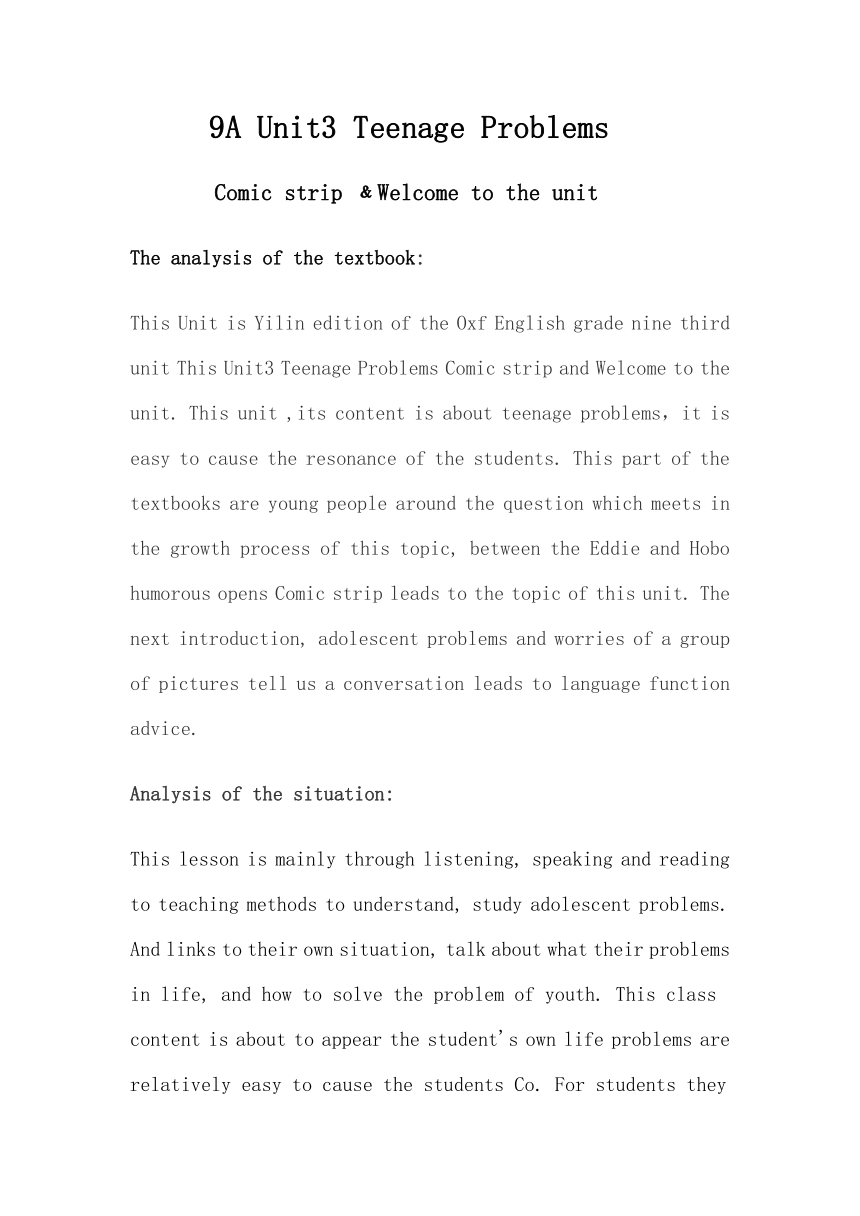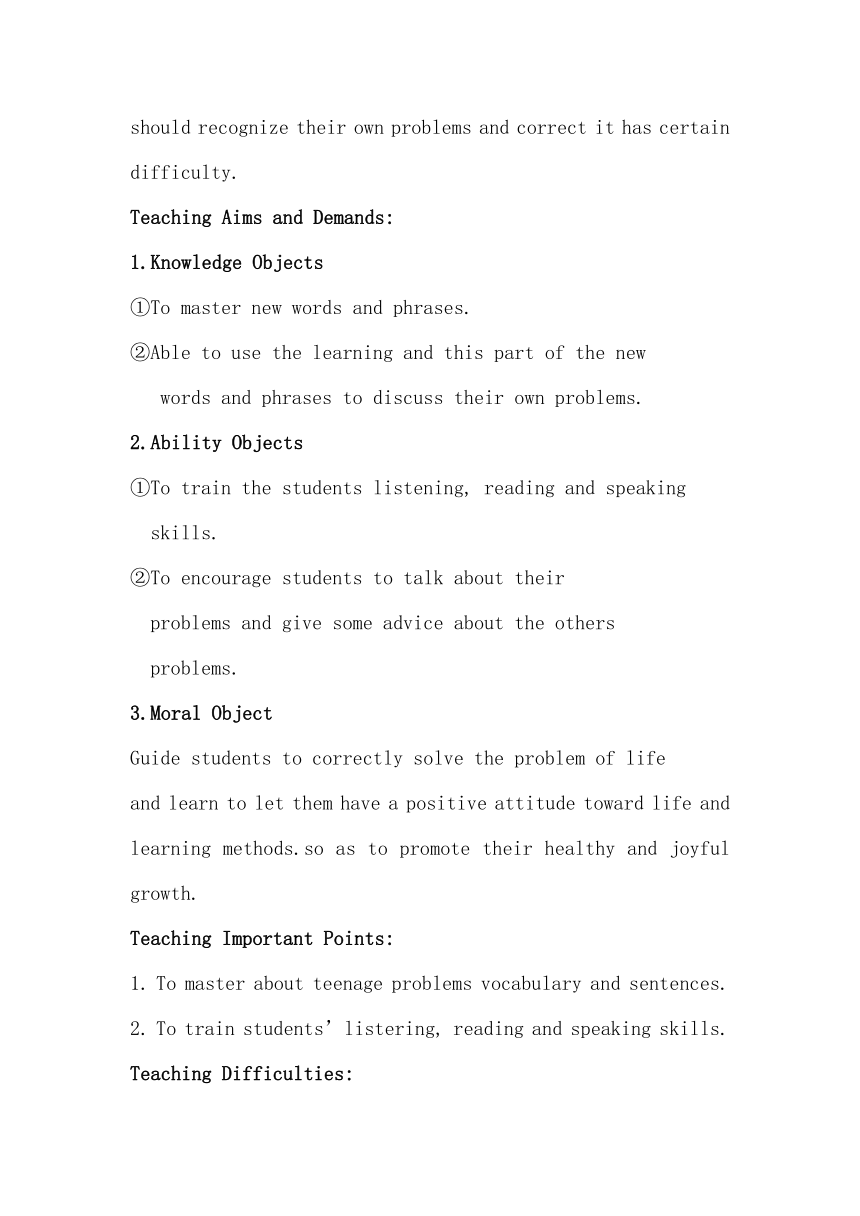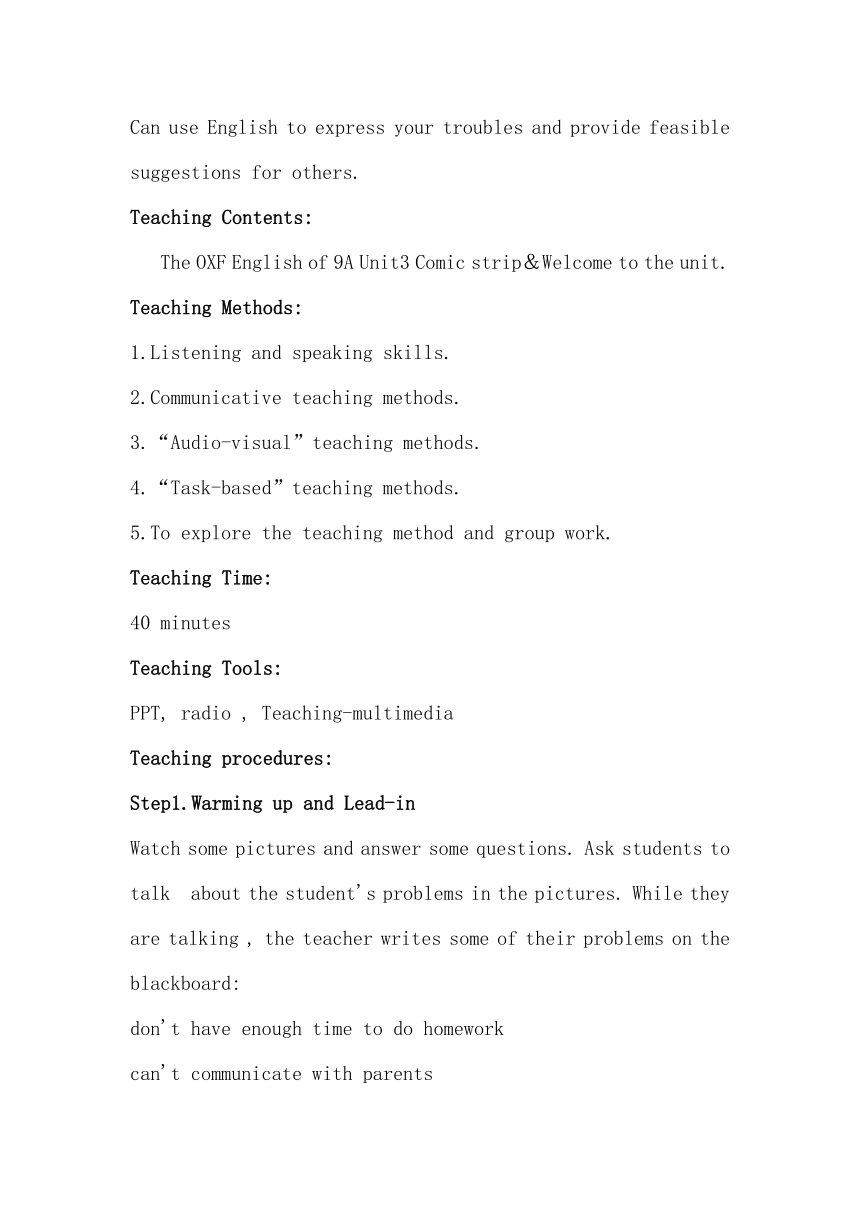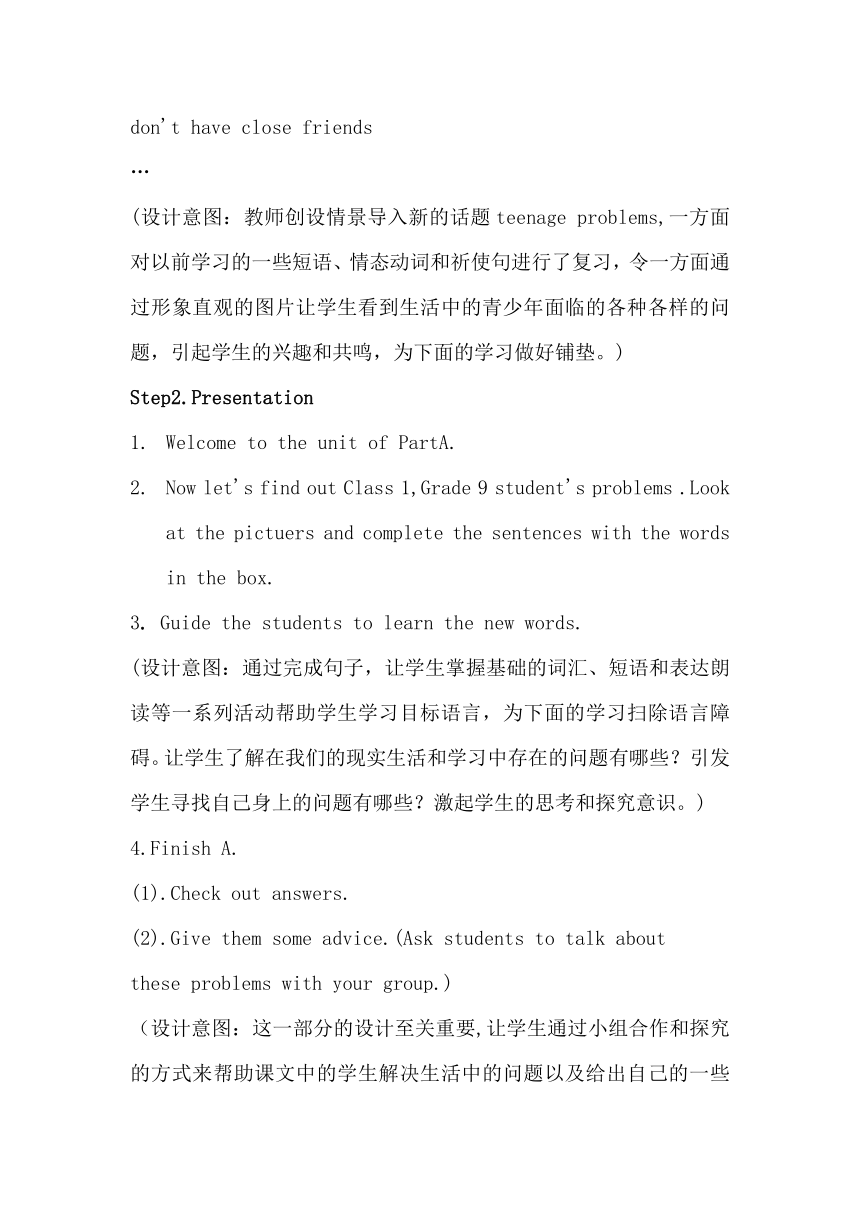Unit 3 Teenage problems Welcome to the unit 教案
文档属性
| 名称 | Unit 3 Teenage problems Welcome to the unit 教案 |  | |
| 格式 | doc | ||
| 文件大小 | 41.5KB | ||
| 资源类型 | 教案 | ||
| 版本资源 | 牛津译林版 | ||
| 科目 | 英语 | ||
| 更新时间 | 2022-12-21 09:04:11 | ||
图片预览




文档简介
9A Unit3 Teenage Problems
Comic strip ﹠Welcome to the unit
The analysis of the textbook:
This Unit is Yilin edition of the Oxf English grade nine third unit This Unit3 Teenage Problems Comic strip and Welcome to the unit. This unit ,its content is about teenage problems,it is easy to cause the resonance of the students. This part of the textbooks are young people around the question which meets in the growth process of this topic, between the Eddie and Hobo humorous opens Comic strip leads to the topic of this unit. The next introduction, adolescent problems and worries of a group of pictures tell us a conversation leads to language function advice.
Analysis of the situation:
This lesson is mainly through listening, speaking and reading to teaching methods to understand, study adolescent problems. And links to their own situation, talk about what their problems in life, and how to solve the problem of youth. This class content is about to appear the student's own life problems are relatively easy to cause the students Co. For students they should recognize their own problems and correct it has certain difficulty.
Teaching Aims and Demands:
1.Knowledge Objects
①To master new words and phrases.
②Able to use the learning and this part of the new
words and phrases to discuss their own problems.
2.Ability Objects
①To train the students listening, reading and speaking
skills.
②To encourage students to talk about their
problems and give some advice about the others
problems.
3.Moral Object
Guide students to correctly solve the problem of life
and learn to let them have a positive attitude toward life and learning methods.so as to promote their healthy and joyful growth.
Teaching Important Points:
1. To master about teenage problems vocabulary and sentences.
2. To train students’listering, reading and speaking skills.
Teaching Difficulties:
Can use English to express your troubles and provide feasible suggestions for others.
Teaching Contents:
The OXF English of 9A Unit3 Comic strip&Welcome to the unit.
Teaching Methods:
1.Listening and speaking skills.
2.Communicative teaching methods.
3.“Audio-visual”teaching methods.
4.“Task-based”teaching methods.
5.To explore the teaching method and group work.
Teaching Time:
40 minutes
Teaching Tools:
PPT, radio , Teaching-multimedia
Teaching procedures:
Step1.Warming up and Lead-in
Watch some pictures and answer some questions. Ask students to
talk about the student's problems in the pictures. While they are talking , the teacher writes some of their problems on the blackboard:
don't have enough time to do homework
can't communicate with parents
don't have close friends
…
(设计意图:教师创设情景导入新的话题teenage problems,一方面对以前学习的一些短语、情态动词和祈使句进行了复习,令一方面通过形象直观的图片让学生看到生活中的青少年面临的各种各样的问题,引起学生的兴趣和共鸣,为下面的学习做好铺垫。)
Step2.Presentation
1. Welcome to the unit of PartA.
2. Now let's find out Class 1,Grade 9 student's problems .Look at the pictuers and complete the sentences with the words in the box.
3. Guide the students to learn the new words.
(设计意图:通过完成句子,让学生掌握基础的词汇、短语和表达朗读等一系列活动帮助学生学习目标语言,为下面的学习扫除语言障碍。让学生了解在我们的现实生活和学习中存在的问题有哪些?引发学生寻找自己身上的问题有哪些?激起学生的思考和探究意识。)
4.Finish A.
(1).Check out answers.
(2).Give them some advice.(Ask students to talk about
these problems with your group.)
(设计意图:这一部分的设计至关重要,让学生通过小组合作和探究的方式来帮助课文中的学生解决生活中的问题以及给出自己的一些建议,引导学生学会有主见的解决生活中的问题。)
ic strip
1. Listen and answer (Let's help our old friend Eddie
find out his problems.)
①.What problem does Eddie have (He eats too much)
②.What is unhealthy for Eddie (He eats too much and not exercises more)
③.What is Hobos 'suggestion (Eat less and exercise more)
④.Why does Hobo tell Eddie not to eat too much (Because it is not healthy.)
2.Check out answers.
(设计意图:让学生在有趣的多媒体动漫的视觉刺激下,怀着好奇的心情去寻找问题的答案,激发了学生学习积极性的同时,也引导学生积极的思考问题且在愉悦的环境下解决了学习上的问题。)
3.Play the tape again and follow it.
4.Act out the dialogue.
(设计意图:通过听和说以及角色扮演的活动激发学生的表达欲望和学生学习的积极性,也顺理成章的吸引他们继续学习本节课接下来的知识。)
Step4.Presentation and practice
1.Read the conversation and answer the questions.
(1)What is Millie’s problem (She feels sleepy in class.)
(2)What should she do then?(She should manage her time better and go to bed earlier.)
(3)Read the conversation together.
(设计意图:打破以前机械式的模仿操练,采用问答式的设计引发学生的思考,也让学生练习怎样用英语组织句子回答问题。通过体验实践参与合作等方式,学习和使用英语,也为中考最后一个阅读的题型多做练习。)
2.Disscuss.
What problems do you have (You can choose say or show your prol)
(设计理念:诱导学生用本节课学习的知识,去正确的语言或者肢体语言去表达自己在生活和学习中出现的问题,从而锻炼学生听、说的能力。)
3.Practice
1.Use your problems to make a conversation is
similer with the part of B
2.Work in pairs to role play the conversation.
(设计理念:本部分的设计承上启下,在上一环节中发现自己的问题,本环节通过对话的方式帮自己也帮别人找到了解决问题的方法,真正掌握和深化了本节课的主题。)
Step5.Summary
T:Everyone has problems.Teenagers have some teenage problems.
Guide the students to go over the important phrases on the blackboard..
T:But we can get advice from others.How do you get advice
Guide the students to go over the sentence structure about giving advice and add more.For example:Let's do sth.Shall we do sth. How/What about doing
T: Some positive suggestions to others,also enhance
their own strength to face the difficulties in life I
hope everyone has always full of vitality.
(设计意图:总结归纳并加以适当的拓展帮助学生更好地掌握本课时所学的内容。)
Step6.Homework
1.Write an email to your friend about how to deal
with his or her problems.
2. Preview reading.
(设计意图:让学生养成巩固旧知识和预习新知识的好习惯。)
Teaching design:
Unit3 Teenage Problems
Words:teenage,exam,examination,mark
Pharses:drive sb.mad,dont't get enough sleep ,feel tired in class,feel lonely,get low marks in exams
dont't have enough time to do sth.
Sentences:Why don't you do sth.
Shall we do sth
How/What about doing sth.
Lets'do sth.
Teaching reflection:
The unit is the subject of adolescent problems, this is an easy for students to resonate with the topic. So easy to exchange and display. The students have some problems, through free dialogue and combined with the problem investigation teaching, constantly present adolescent problems, laying the foundation for the following teaching. We should fully mobilize the enthusiasm of learning of students in teaching, at the end of the dialogue, let the students to apply what they have learned, and buried the foreshadowing for behind the Reading and Main task study.
Comic strip ﹠Welcome to the unit
The analysis of the textbook:
This Unit is Yilin edition of the Oxf English grade nine third unit This Unit3 Teenage Problems Comic strip and Welcome to the unit. This unit ,its content is about teenage problems,it is easy to cause the resonance of the students. This part of the textbooks are young people around the question which meets in the growth process of this topic, between the Eddie and Hobo humorous opens Comic strip leads to the topic of this unit. The next introduction, adolescent problems and worries of a group of pictures tell us a conversation leads to language function advice.
Analysis of the situation:
This lesson is mainly through listening, speaking and reading to teaching methods to understand, study adolescent problems. And links to their own situation, talk about what their problems in life, and how to solve the problem of youth. This class content is about to appear the student's own life problems are relatively easy to cause the students Co. For students they should recognize their own problems and correct it has certain difficulty.
Teaching Aims and Demands:
1.Knowledge Objects
①To master new words and phrases.
②Able to use the learning and this part of the new
words and phrases to discuss their own problems.
2.Ability Objects
①To train the students listening, reading and speaking
skills.
②To encourage students to talk about their
problems and give some advice about the others
problems.
3.Moral Object
Guide students to correctly solve the problem of life
and learn to let them have a positive attitude toward life and learning methods.so as to promote their healthy and joyful growth.
Teaching Important Points:
1. To master about teenage problems vocabulary and sentences.
2. To train students’listering, reading and speaking skills.
Teaching Difficulties:
Can use English to express your troubles and provide feasible suggestions for others.
Teaching Contents:
The OXF English of 9A Unit3 Comic strip&Welcome to the unit.
Teaching Methods:
1.Listening and speaking skills.
2.Communicative teaching methods.
3.“Audio-visual”teaching methods.
4.“Task-based”teaching methods.
5.To explore the teaching method and group work.
Teaching Time:
40 minutes
Teaching Tools:
PPT, radio , Teaching-multimedia
Teaching procedures:
Step1.Warming up and Lead-in
Watch some pictures and answer some questions. Ask students to
talk about the student's problems in the pictures. While they are talking , the teacher writes some of their problems on the blackboard:
don't have enough time to do homework
can't communicate with parents
don't have close friends
…
(设计意图:教师创设情景导入新的话题teenage problems,一方面对以前学习的一些短语、情态动词和祈使句进行了复习,令一方面通过形象直观的图片让学生看到生活中的青少年面临的各种各样的问题,引起学生的兴趣和共鸣,为下面的学习做好铺垫。)
Step2.Presentation
1. Welcome to the unit of PartA.
2. Now let's find out Class 1,Grade 9 student's problems .Look at the pictuers and complete the sentences with the words in the box.
3. Guide the students to learn the new words.
(设计意图:通过完成句子,让学生掌握基础的词汇、短语和表达朗读等一系列活动帮助学生学习目标语言,为下面的学习扫除语言障碍。让学生了解在我们的现实生活和学习中存在的问题有哪些?引发学生寻找自己身上的问题有哪些?激起学生的思考和探究意识。)
4.Finish A.
(1).Check out answers.
(2).Give them some advice.(Ask students to talk about
these problems with your group.)
(设计意图:这一部分的设计至关重要,让学生通过小组合作和探究的方式来帮助课文中的学生解决生活中的问题以及给出自己的一些建议,引导学生学会有主见的解决生活中的问题。)
ic strip
1. Listen and answer (Let's help our old friend Eddie
find out his problems.)
①.What problem does Eddie have (He eats too much)
②.What is unhealthy for Eddie (He eats too much and not exercises more)
③.What is Hobos 'suggestion (Eat less and exercise more)
④.Why does Hobo tell Eddie not to eat too much (Because it is not healthy.)
2.Check out answers.
(设计意图:让学生在有趣的多媒体动漫的视觉刺激下,怀着好奇的心情去寻找问题的答案,激发了学生学习积极性的同时,也引导学生积极的思考问题且在愉悦的环境下解决了学习上的问题。)
3.Play the tape again and follow it.
4.Act out the dialogue.
(设计意图:通过听和说以及角色扮演的活动激发学生的表达欲望和学生学习的积极性,也顺理成章的吸引他们继续学习本节课接下来的知识。)
Step4.Presentation and practice
1.Read the conversation and answer the questions.
(1)What is Millie’s problem (She feels sleepy in class.)
(2)What should she do then?(She should manage her time better and go to bed earlier.)
(3)Read the conversation together.
(设计意图:打破以前机械式的模仿操练,采用问答式的设计引发学生的思考,也让学生练习怎样用英语组织句子回答问题。通过体验实践参与合作等方式,学习和使用英语,也为中考最后一个阅读的题型多做练习。)
2.Disscuss.
What problems do you have (You can choose say or show your prol)
(设计理念:诱导学生用本节课学习的知识,去正确的语言或者肢体语言去表达自己在生活和学习中出现的问题,从而锻炼学生听、说的能力。)
3.Practice
1.Use your problems to make a conversation is
similer with the part of B
2.Work in pairs to role play the conversation.
(设计理念:本部分的设计承上启下,在上一环节中发现自己的问题,本环节通过对话的方式帮自己也帮别人找到了解决问题的方法,真正掌握和深化了本节课的主题。)
Step5.Summary
T:Everyone has problems.Teenagers have some teenage problems.
Guide the students to go over the important phrases on the blackboard..
T:But we can get advice from others.How do you get advice
Guide the students to go over the sentence structure about giving advice and add more.For example:Let's do sth.Shall we do sth. How/What about doing
T: Some positive suggestions to others,also enhance
their own strength to face the difficulties in life I
hope everyone has always full of vitality.
(设计意图:总结归纳并加以适当的拓展帮助学生更好地掌握本课时所学的内容。)
Step6.Homework
1.Write an email to your friend about how to deal
with his or her problems.
2. Preview reading.
(设计意图:让学生养成巩固旧知识和预习新知识的好习惯。)
Teaching design:
Unit3 Teenage Problems
Words:teenage,exam,examination,mark
Pharses:drive sb.mad,dont't get enough sleep ,feel tired in class,feel lonely,get low marks in exams
dont't have enough time to do sth.
Sentences:Why don't you do sth.
Shall we do sth
How/What about doing sth.
Lets'do sth.
Teaching reflection:
The unit is the subject of adolescent problems, this is an easy for students to resonate with the topic. So easy to exchange and display. The students have some problems, through free dialogue and combined with the problem investigation teaching, constantly present adolescent problems, laying the foundation for the following teaching. We should fully mobilize the enthusiasm of learning of students in teaching, at the end of the dialogue, let the students to apply what they have learned, and buried the foreshadowing for behind the Reading and Main task study.
